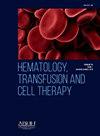以铂为基础的放化疗作为现实世界中晚期头颈部鳞状细胞癌的最终治疗方法
IF 1.6
Q3 HEMATOLOGY
引用次数: 0
摘要
头颈部鳞状细胞癌(HNSCC)是全球最常见的恶性肿瘤之一,超过60%的患者表现为局部区域晚期肿瘤。铂基放化疗是一种广泛采用的治疗方法,用于无法切除的局部晚期HNSCC,不适合手术和因潜在并发症而拒绝手术的患者。虽然这种方法在发达国家产生了良好的结果,但其在发展中国家现实环境中的有效性仍未得到充分探讨。在这种情况下调查治疗结果对于优化肿瘤治疗至关重要。目的评估局部晚期HNSCC患者接受终期铂基放化疗的毒性、肿瘤反应、无事件生存期(EFS)和总生存期(OS)。材料与方法本回顾性研究纳入233例在坎皮纳斯大学总医院肿瘤科(UNICAMP)接受治疗的患者。纳入标准包括18岁或以上,东部肿瘤合作组(ECOG) 2或更低,接受放疗(RT)联合每周一次或每三周给予顺铂(CDDP)或卡铂(Carbo)作为最终治疗的患者。根据美国国家癌症研究所不良事件通用术语标准(NCI CTCAE v5.0)标准记录3级或4级不良事件。实体肿瘤反应评价标准(RECIST)标准。生存结果采用Kaplan-Meier法估计,单因素和多因素分析采用log-rank检验和Cox比例风险回归进行统计比较。结果入组患者的中位年龄为60岁。大多数入组受试者为男性,活跃或既往吸烟者和饮酒者,具有良好的运动状态和合并症,表现为中分化和晚期肿瘤。肿瘤均匀分布于口腔、咽、喉。一半的患者出现3级或4级毒性,恶心/呕吐和肾毒性在RT + CDDP组中更常见,而贫血和中性粒细胞减少在RT + Carbo组中占主导地位。共有75%的患者达到了完全或部分肿瘤缓解,治疗方案没有显著影响。2年EFS和OS率分别为43.3%和66.0%。不良预后与积极吸烟、ECOG表现状态≥2、IV期疾病和RT + Carbo治疗相关。具有这些特征的患者出现复发和疾病进展导致死亡的风险大约高出两倍。结论:本研究强调了RT和CDDP是巴西一家公立医院局部晚期HNSCC患者最有效的最终治疗方法。然而,对这些患者进行进一步的前瞻性和随机III期研究对于确定这些患者的最佳治疗策略至关重要。本文章由计算机程序翻译,如有差异,请以英文原文为准。
PLATINUM-BASED CHEMORADIOTHERAPY AS DEFINITIVE TREATMENT IN ADVANCED SQUAMOUS CELL CARCINOMA OF HEAD AND NECK IN REAL-WORLD SETTING
Introduction/Justification
Head and neck squamous cell carcinoma (HNSCC) is one of the most prevalent malignant tumor globally, and over 60% of patients present locoregionally advanced tumors. Platinum-based chemoradiotherapy is a widely adopted treatment for patients with unresectable locoregionally advanced HNSCC, those ineligible for surgery and those refusing surgery due to potential sequelae. While this approach has yielded favorable results in developed countries, its effectiveness in real-world settings in developing countries remains underexplored. Investigating treatment outcomes in this context is essential for optimizing oncologic care.
Objectives
To assess the toxicity profile, tumor response, event-free survival (EFS), and overall survival (OS) in patients with locoregionally advanced HNSCC treated with definitive platinum-based chemoradiotherapy.
Materials and Methods
This retrospective study included 233 patients treated at the Oncology Service of the General Hospital of University of Campinas (UNICAMP). Inclusion criteria encompassed patients aged 18 or older, with an Eastern Cooperative Oncology Group (ECOG) of 2 or lower, who underwent radiotherapy (RT) combined with either weekly or every-three-weeks administration of cisplatin (CDDP) or carboplatin (Carbo) as definitive treatment. Grade 3 or 4 adverse events were documented according to the National Cancer Institute, Common Terminology Criteria for Adverse Events (NCI CTCAE v5.0) standards. Response Evaluation Criteria in Solid Tumors (RECIST) criteria. Survival outcomes were estimated with the Kaplan-Meier method, and statistical comparisons were performed using the log-rank test and Cox proportional hazards regression for univariate and multivariate analyses.
Results
The median age of patients enrolled in study was 60 years. Most enrolled subjects were males, active or former smokers and drinkers, had good performance status and comorbidities, and presented moderately differentiated and advanced tumors. Tumors were equally distributed in oral cavity, pharynx and larynx. Half of the patients developed grade 3 or 4 toxicities, with nausea/vomiting and nephrotoxicity being more frequently observed in the RT + CDDP group, while anemia and neutropenia were predominant in the RT + Carbo group. A total of 75% of patients achieved either complete or partial tumor response, with no significant impact from the treatment regimen. The two-year EFS and OS rates were 43.3% and 66.0%, respectively. Poor prognosis was associated with active smoking, ECOG performance status ≥ 2, stage IV disease, and treatment with RT + Carbo. Patients with these characteristics had an approximately twofold higher risk of presenting relapse and disease progression leading to death.
Conclusion
This study highlights RT and CDDP as the most effective definitive treatment for patients with locoregionally advanced HNSCC from a Brazilian public hospital. Nevertheless, further prospective and randomized phase III study conducted with those patients is essential to define the optimal treatment strategy for these patients Acknowledgements: The study was supported by Coordenação de Aperfeiçoamento de Pessoal de Nível Superior (CAPES).
求助全文
通过发布文献求助,成功后即可免费获取论文全文。
去求助
来源期刊

Hematology, Transfusion and Cell Therapy
Multiple-
CiteScore
2.40
自引率
4.80%
发文量
1419
审稿时长
30 weeks
 求助内容:
求助内容: 应助结果提醒方式:
应助结果提醒方式:


